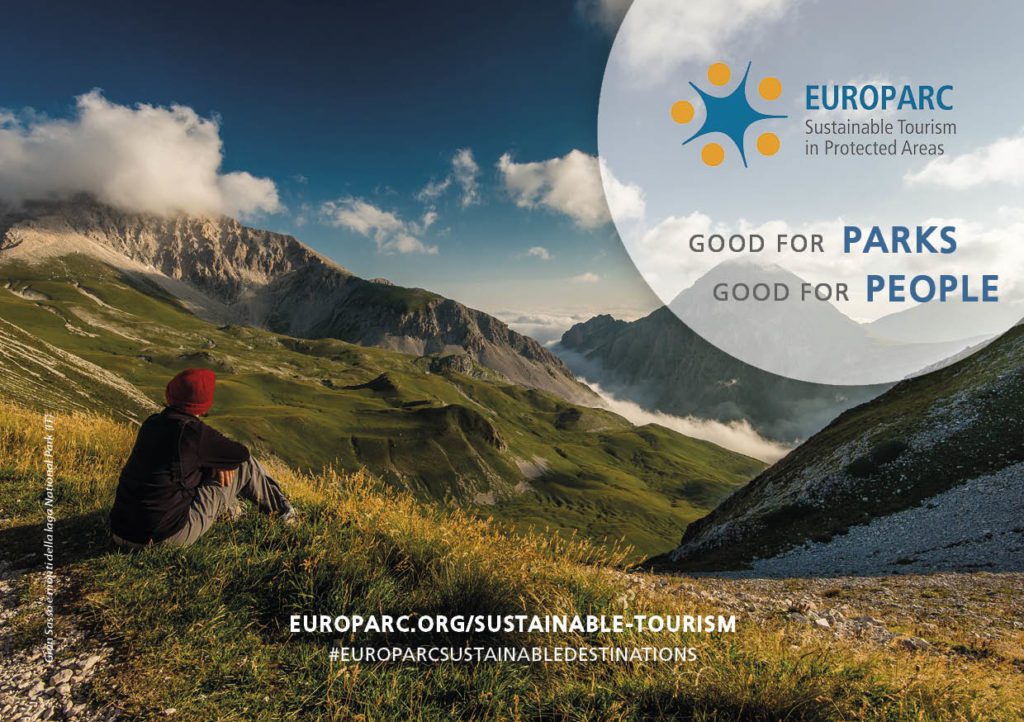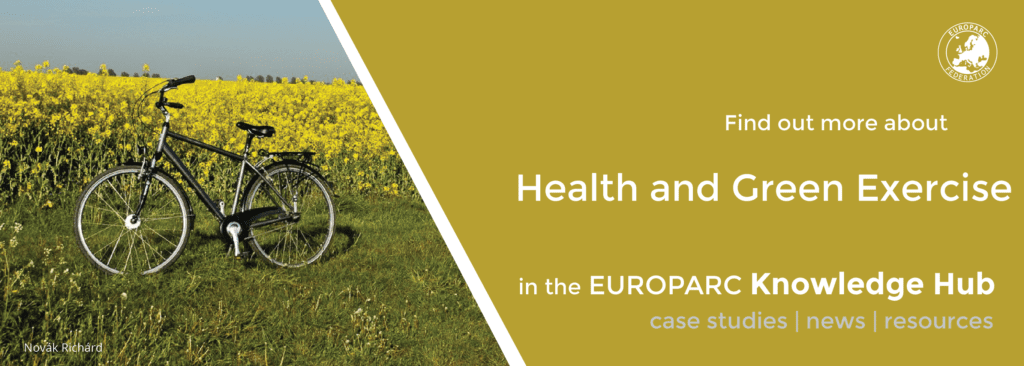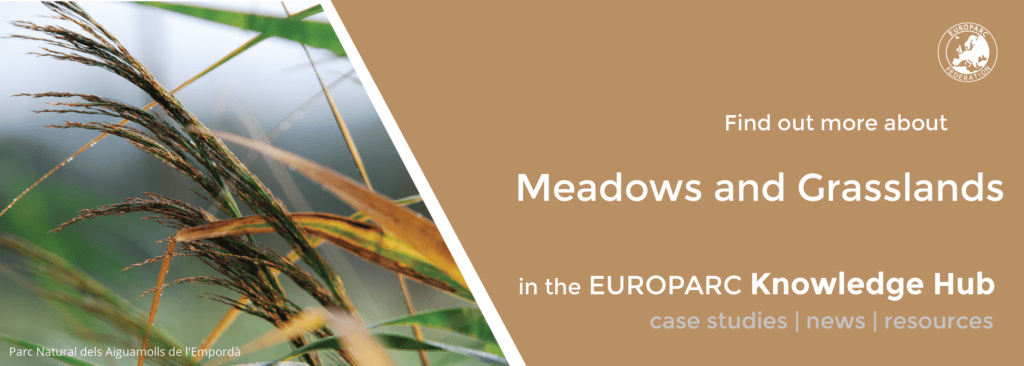Charter Award Ceremony 2019 – Registrations are open!
The Charter Award Ceremony 2019
We are proud to invite you to the Charter Award Ceremony 2019, our annual high-level event host in Brussels, to recognise the work of Protected Areas towards achieving sustainability in tourism. This year we will celebrate the successful applications of 16 EUROPARC Sustainable Destinations, some of them awarded for the first time while others, that have implemented the methodology before, will be awarded for the renewal of their commitment.
The event will take place on December 2nd, from 14:00 to 18:00, in the European Committee of the Regions, kindly hosted by Roby Biwer, Vice-Chair of the ENVE Commission of the Committee of the Regions.
The Charter methodology enables Protected Areas to become an active player in the development of sustainable tourism in their region. With a high involvement of the local authorities, businesses and community, the methodology involves the creation of a common Sustainable Tourism Strategy and an Action plan for a period of 5 years.
During the ceremony, we will hear first-hand insights from the Sustainable Destinations that will be awarded and look at the importance of establishing private-public partnerships towards a sustainable development of Europe’s rural territories.
The ceremony will be streamed at https://youtu.be/_FPRyMNvm6E
Celebrating success with Protected Areas and their Business Partners!
A remarkable new aspect of the Charter Award Ceremony this year, is the official announcement of the winners of EUROPARC Star Awards, a prize to champion and acknowledge the effort and investments made by tourism businesses working with our Sustainable Destinations across Europe.
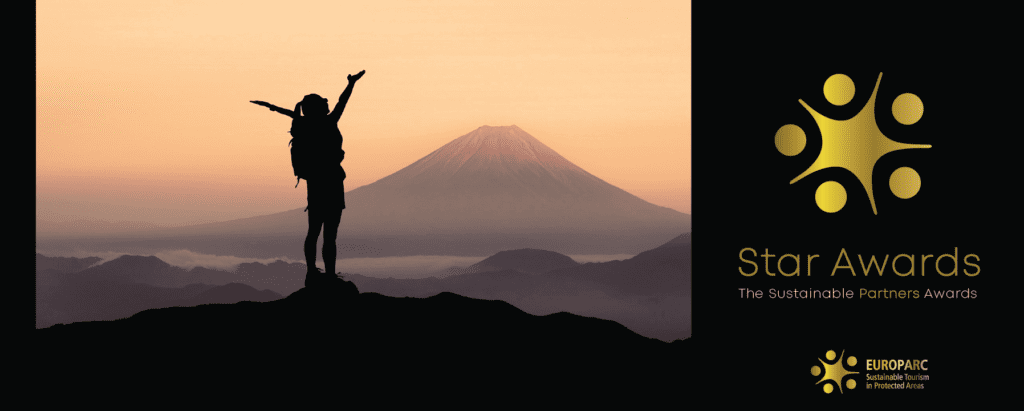
The implementation of the Charter is an opportunity to work side-by-side with local business partners and ensure that tourism can bring social and economic benefits to the local community, but also to inspire and support managers in pursuing a more sustainable approach in their business models.
The Star Awards will be awarded to the businesses that have been active in the protection of their natural and cultural heritage, who are innovative and working to reduce environmental impacts, and to those inspiring a sustainable behavior with their clients.
Registrations
Please note that if you are attending the Charter Award Ceremony, registration is needed to access the Committee of the Regions. Please register below:
Register here
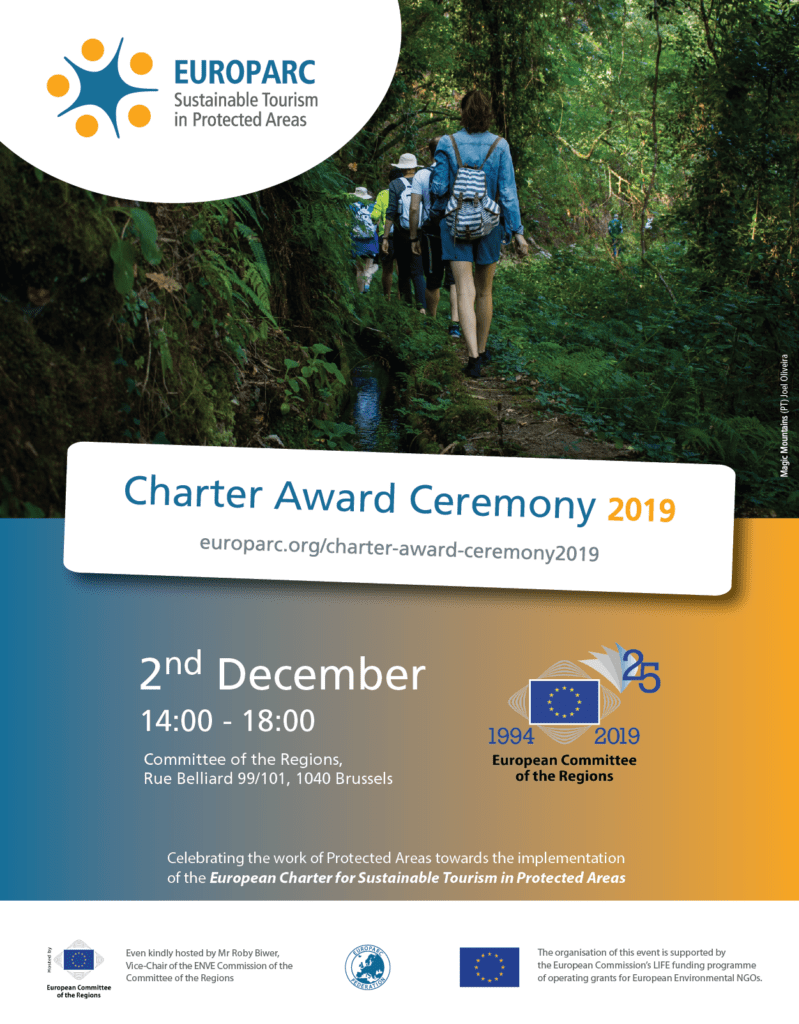
Get to know the Parks that will be awarded!
EUROPARC network counts with 106 Sustainable Destinations (soon 110!) from 16 countries. They are spread all over Europe but united by a shared vision: to make sustainable tourism a meaningful quality experience which safeguards natural and cultural values, supports local livelihoods and quality of life and is economically viable.
The 4 New Sustainable Destinations
Italy
- IT – Maremma Regional Park
- IT – Stelvio National Park
Estonia
- EE – Lahemaa National Park
Spain
- ES – Capcaleres del Ter i del Freeser Nature Park
The 12 Sustainable Destinations that will renew their commitment
France
- FR – Loire Anjou Touraine Nature Regional Park
Italy
- IT – Sibillini National Park
- IT – Torre Cerrano Marine Protected Area
- IT- Alta Murgia National Park
- IT – Pollino National Park
- IT – Colline Metallifere National Park
- IT – Appennino Tosco Emiliano National Park
Spain
- ES – Sierra Nevada National Park
- ES – Donana National Park
Portugal
- PT – Montanhas Mágicas/Magic Mountains
Lithuania
- LT – Zemaitija National Park
Finland
- FI – Pallas-Yllästunturi National Park
Take a look on the previous Charter Award Ceremonies 2017 and 2018.
The European Charter for Sustainable Tourism in Protected Areas is a methodology created by the EUROPARC Federation, with the aim of supporting protected areas to become Sustainable Destinations through an active involvement of their local stakeholders.
Get a deeper insight on the European Charter for Sustainable Tourism in Protected Areas
Healthy green paths in periurban areas: a case study from Barcelona
Source: Xarxa de Parcs Naturals, Facebook page
After many municipalities in the Province of Barcelona showed their interest to develop healthy green paths in periurban areas, the Provincial Council launched a pilot project to answer them. Beginning in four municipalities that are close to Protected Areas, the goal of the project was to promote physical activity in nature as a healthy habit for everyone, but also to design trails and therapeutic activities to specific target groups with health disorders.
The Barcelona Metropolitan area, where five million people live, is surrounded by a network of 12 Protected Areas managed by the Provincial Council of Barcelona. In 2018, the Council started a pilot project in four municipalities close to the Protected Areas, with two main goals:
- to promote outdoor physical activity as a healthy habit among people in periurban natural environment,
- to target groups with specific disorders (such as mental disease or chronic pains) with special trails and activities.
Nowadays, several municipalities have these programs underway.
Read also the original case study on healthy paths in Barcelona, and one study from Scotland, focusing on health benefits of periurban parks.
Parks and Protected Areas provide many facilities and activities to promote health in natural surroundings close to cities. There is a high demand of green environments to develop daily activities. In periurban areas, these activities become accessible for many.
Tailor-made solutions
Given the different backgrounds of municipalities, a pilot project was developed with four of them. The aim was to adapt the actions to the real demand of each municipality. In some cases new healthy paths have been established; in other places, paths were already existing and the need was to liven up with activities; and in some other cases, direct collaboration with the local health sector has been key to reach target groups with specific health needs.
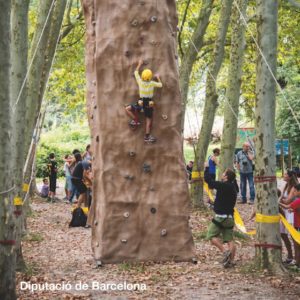
Source: Xarxa de Parcs Naturals, Facebook page
Key actions to promote healthy green paths in periurban areas:
- Identification of key local stakeholders, from politicians and experts to medical practitioners, protected area managers, NGOs and associations;
- Definition of the scenario and prioritise actions with stakeholders;
- Taking action: it can be the development of new healthy paths, or areas for healthy activities; programs to encourage more people to use them; collaboration with health practitioners to start therapies with target groups.
Concerning project partners, Protected Area managers or environment and health departments on provincial and regional level have taken part in the project. On the other hand, all stakeholders from the environment and health sectors (public, private, social) have been involved on local municipal level.
A network of healthy paths
Nowadays, several municipalities have a network of healthy paths to promote relaxing and physical activity in nature. Some of them also have a program of activities (including path guidance, therapeutic treatments for target groups etc.) supported by the Provincial Council. Some initiatives on the Catalan level have emerged through the collaboration between public and private partners from the health and environmental sectors.
There is not a unique and right solution for all places – each municipality and Protected Area has a different background and needs.
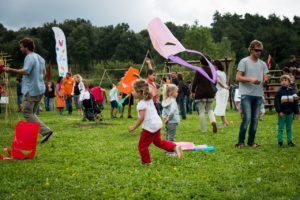
Source: Xarxa de Parcs Naturals, Facebook page
Although it has been sometimes difficult to find suitable and accessible natural places, and it cost huge efforts to keep the different partners involved due to the lack of time and resources, the project has brought an efficient network of healthy green paths and an inspiration for many others.
According to Carles Castell from the Provincial Council of Barcelona, the best recipe is to acknowledge that there is not a unique and right solution for all places – each municipality and Protected Area has a different background and needs. It is essential to identify local stakeholders, analyse the situation, define priorities and most importantly, create a strong link between the health and environmental sectors.
For more information about the project, visit the website of the Provincial Council of Barcelona or contact Carles Castell on castellpc @ diba.cat.
The Good Principles for Outdoor Sports now in 6 languages!
On the occasion of the 2019 European Week of Sports, the EUROPARC Federation and the European Network of Outdoor Sports (ENOS) launched simultaneously the 10 Good Principles for Outdoor Sports in Protected Areas (PAs) during their respective Conferences. This is the result of a fruitful cooperation between both associations and the first outcome of the Memorandum of Understanding signed last year by EUROPARC and ENOS.
The Good Principles for Outdoor Sports now in 6 languages!
After the launch of The 10 Good Principles for Outdoor Sports just a few weeks ago, it is time to continue inspiring people to follow them. The Principles aim to promote good conduct among outdoor sports practitioners. For that, we are adapting the Good Principles in different digital formats and languages so they can be endorsed by all Protected Areas across Europe.
The Principles are now available in 6 new languages: French, Spanish, German, Czech, Italian and Portuguese.
What can you do?
Endorse the principles and share them on your website, among your contacts and on your social media accounts with #OutdoorSports. You can also inspire your visitors, by displaying the Principles in your information points and visitors centers. We are also preparing communications material that you can personalise with your Park´s photos and share with your visitors.
If you would also like to have the Principles in your language, download this file and send us back the translated version to a.robles@europarc.org. We will gladly produce the promotion materials in your language.
You can also contribute with your experience. The next step of EUROPARC and ENOS´ cooperation is to identify good practice for each sports discipline, in order to create principles and guidance that can support park managers and inspire practitioners. So if you have good examples of sports events you have organised or measures you have implemented in our Protected Area or region, we invite you to submit a case study.
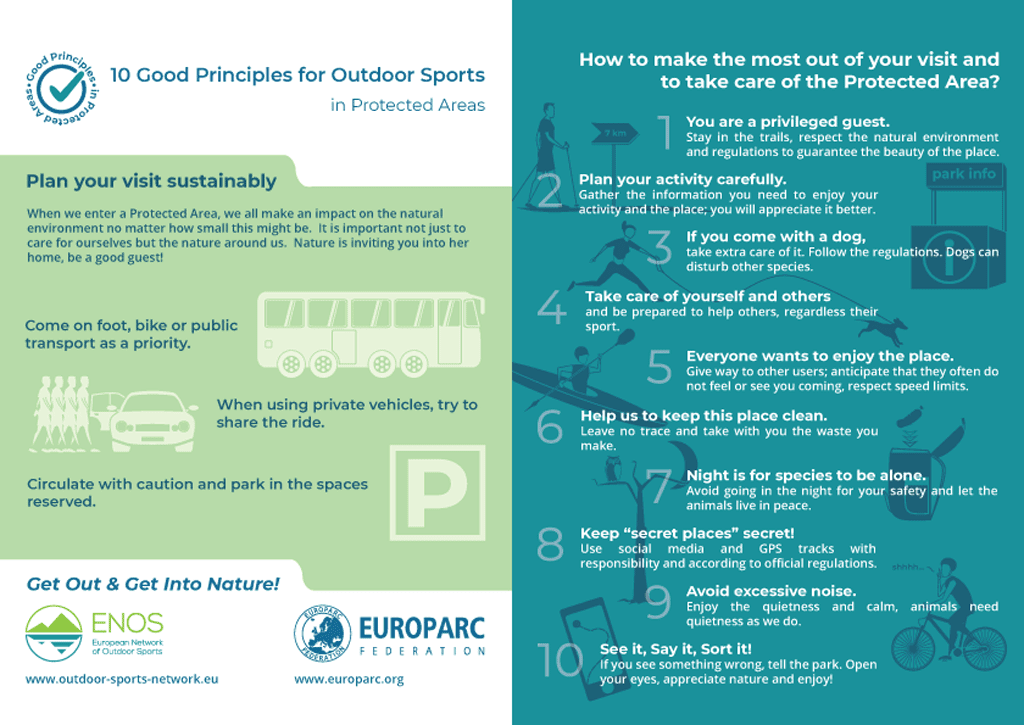
10 Good Principles for Outdoor Sports leaflet (Download it on the Outdoor Sports page)
Download The Good Principles for Outdoor Sports:
PDF versions
FR 10 principles for outdoor sports
DE 10 principles for outdoor sports
ES 10 principles for outdoor sports
CZ 10 principles for outdoor sports
IT 10 principles fro outdoor sports
PT 10 principles for outdoor sports
CAT 10 principles for outdoor sports
PNG versions
FR_Good Principles Outdoor Sports (png)
DE_Good Principles Outdoor Sports (png)
ES_Good Principles Outdoor Sports (png)
CZ_Good Principles Outdoor Sports (png)
IT_Good Principles Outdoor Sports (png)
Restoring semi-natural grassland with landowners and farmers: a case study from Estonia
Alvar -LIFE to alvars project Website
Alvars are a semi-natural grassland, very limited in their global distribution. One third of them are in Estonia. LIFE to Alvars cooperates with landowners and farmers in order to maintain the second richest ecosystem of the country. As a recognition of the hard work, the project received a Natura 2000 Award in the category “Socio-economic benefits” in 2018.
The decline of pastures, decline of biodiversity
Alvar grasslands are semi-natural grasslands with thin lime-rich soil on limestone bedrock. The number of vascular plants is the richest in species in Estonia after wooded meadows.
Within the European Union, alvars are only found in Sweden and Estonia, with minor areas in south-west Finland. The decrease of alvar grassland habitat area started in the 1950s when the traditional extensive agricultural activities were widely replaced by intensive land-use. In 2013 less than 30% of the Estonian Alvar surface (around 2000 ha) were under annual management, which is necessary for the long-term persistence of this habitat type.
Read also these two studies about grassland management in protected areas in post-communist countries and about the management of wet-grasslands.
The emergence and survival of these semi-natural communities, or heritage communities, is closely linked to traditional activities. Pastoralism is the main human activity that allows these enormously biodiverse grasses to persist.
Decline in grazing has led Alvars to overgrow with shrubs (mainly Juniperus communis) and trees (mostly Pinus sylvestris). The abandonment and afforestation are a threat to its integrity.
Why should we protect them?
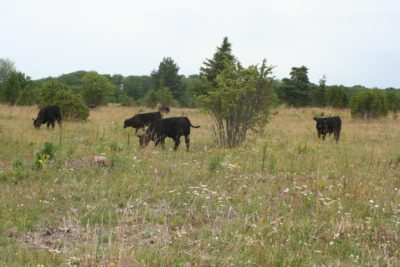
Alvar
- Exceptional biodiversity as compared with intensively managed pasture, providing habitat for wildlife.
- Valuable carbon store, especially without reseeding and fertilizers.
- Responsible for major part of the environmental public goods of European farming.
- Other ecosystem services such as preventing erosion and nutrient migration and filtering water.
From the Iberian dehesas to the Nordic wooded meadows, they’ve been actively farmed for centuries, being an integral part of the forage system.
The Actions: Forestry and community involvement
Carried by the Estonian Environmental Board, the five years-project (which ended in September 2019) has worked out and successfully used a completely novel approach to alvar restoration. It has also contributed to the Estonian Nature Conservation Development Plan 2020.
The following actions were taken within the project:
- Removing trees and shrubs with common forestry and communal machinery.
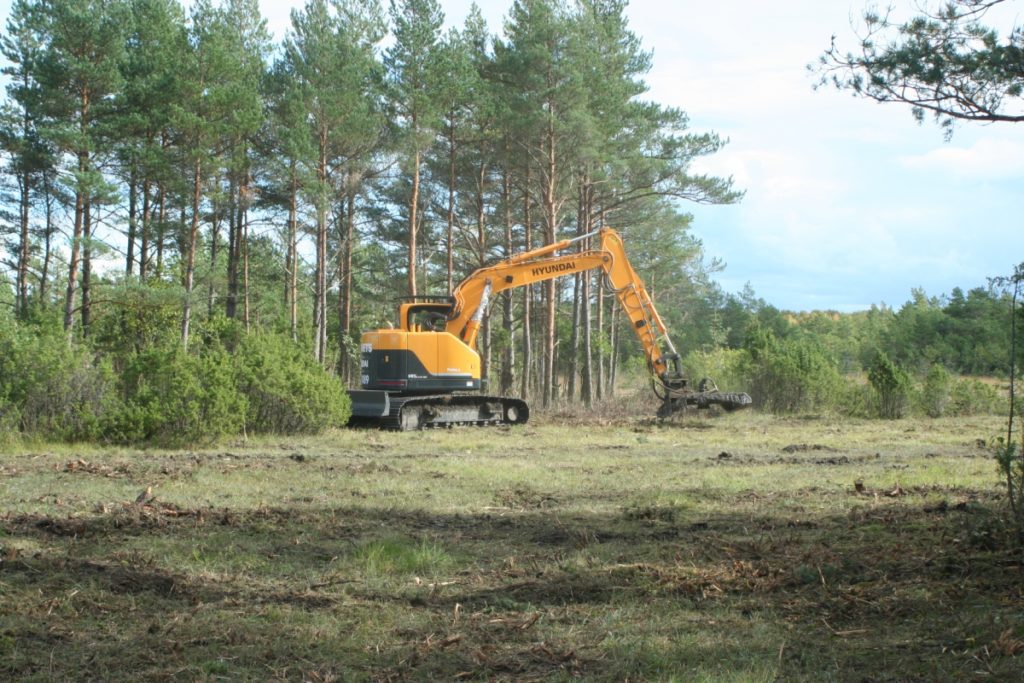
Chain crusher – LIFE to alvars project Website
- Providing equipment, so that each restored area is equipped with grazing infrastructures such as shelters and access to water and roads to ensure continuous management.
- Partnership contracts were signed with land-owners, farmers and the project.
- Dissemination actions
- Annual public meetings, working groups, and study trips were held.
- Promotion of the project with information boards, leaflets, exhibitions and media work.
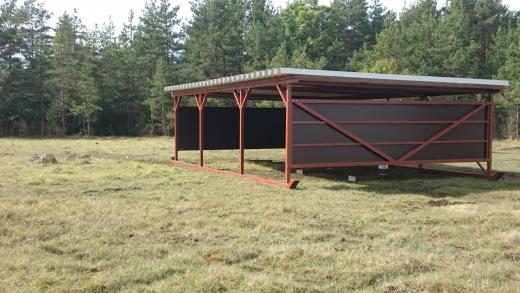
Animal shelter – LIFE to alvars project Website
Results:
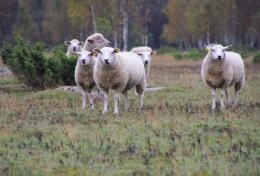
LIFE to alvars project Website
- Altogether, 2500 hectares of most valuable alvar grasslands were restored and the areas have joined the CAP semi-natural grassland management scheme.
- All the restored areas are equipped with grazing infrastructure for their subsequent management by local farmers.
- 600 landowners and 41 local farmers and farming companies were involved in the restoration activities
- Restoration has resulted in a significant increase in plant species richness, particularly in former afforested and shrub-covered areas.
It is all about people. The opinion of the general public and people involved in the project is a key element in gaining success in large scale restoration on private land.
“The community involvement is fundamental when working in private land. A lot of effort has been put into communication and convincing. Finding trustworthy local farmers interested in management and making agreements for continuous management is the second most important key element in maintaining the restoration result long term,” said Ms Annely Holm, from the Estonian Environmental Board and Project Manager of LIFE to Alvars.
LIFE to alvars project was financed by the European Commission LIFE + Nature programme in 2014. Project identification code is LIFE13NAT/EE/000082. The project is co-financed by the Estonian Environmental Investment Centre and by the partners’ self-financing. Project budget is 3 725 865 euros. Lead partner is the Estonian Environmental Board and partners are the University of Tartu, Estonian University of Life Sciences and Seminatural Communities Conservation Association.
